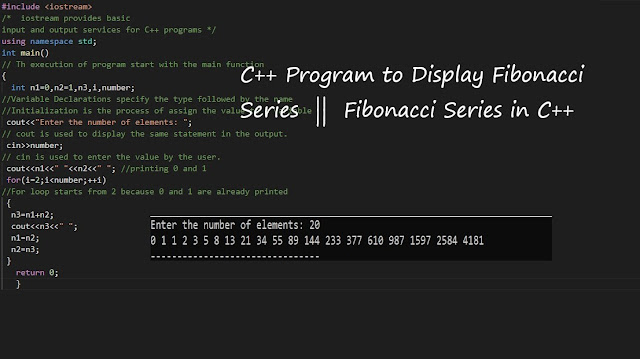C++ Program to Display Fibonacci Series:
Fibonacci Series in C++:
Fibonacci series next number the sum of previous two numbers for example 0, 1, 1, 2, 3, 5, 8, 13, 21 , 34 , 55etc. The first two numbers of fibonacci series are 0 and 1.
There are two ways to write the fibonacci series program:
- Fibonacci Series without recursion
- Fibonacci Series using recursion
Fibonacci series program in C++ without recursion.
Source code:
#include <iostream>
/* iostream provides basic
input and output services for C++ programs */
using namespace std;
int main()
// Th execution of program start with the main function
{
int n1=0,n2=1,n3,i,number;
//Variable Declarations specify the type followed by the name
//Initialization is the process of assign the value to a variable
cout<<"Enter the number of elements: ";
// cout is used to display the same statement in the output.
cin>>number;
// cin is used to enter the value by the user.
cout<<n1<<" "<<n2<<" "; //printing 0 and 1
for(i=2;i<number;++i)
//For loop starts from 2 because 0 and 1 are already printed
{
n3=n1+n2;
cout<<n3<<" ";
n1=n2;
n2=n3;
}
return 0;
}
Fibonnaci series using recursion in C++:
fibonacci series program in C++ using recursion.
Source code:
#include<iostream>
/* iostream provides basic
input and output services for C++ programs */
using namespace std;
void printFibonacci(int n){
static int n1=0, n2=1, n3;
if(n>0){
n3 = n1 + n2;
n1 = n2;
n2 = n3;
cout<<n3<<" ";
printFibonacci(n-1);
}
}
int main()
// Th execution of program start with the main function
{
int n;
cout<<"Enter the number of elements: ";
cin>>n;
cout<<"Fibonacci Series: ";
cout<<"0 "<<"1 ";
printFibonacci(n-2);
//n-2 because 2 numbers are already printed
return 0;
}









0 Comments